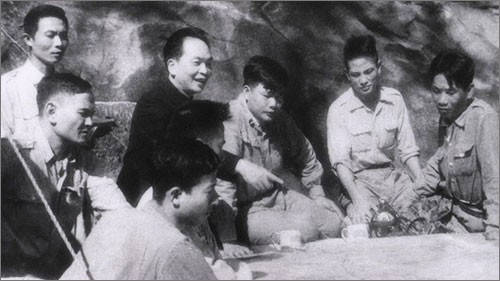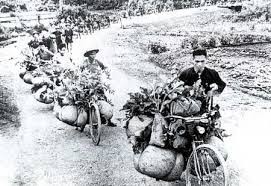(VOVworld) – The Dien Bien Phu victory 60 years ago ended the 9-year resistance war of Vietnamese soldiers and people against French colonization. The victory was a milestone in Vietnam’s history of national construction and defense and a daring exploit in the global history of the 20th century. It motivated peace lovers around the world to continue fighting against colonization to gain national independence.
 |
General Vo Nguyen Giap discussed with his commanders prior to the Dien Bien Phu campaign
|
When discussing the Dien Bien Phu victory, Vietnamese and foreign military historians have emphasized the contribution of the Party’s revolutionary guidelines, Vietnam’s national unity, and the wise strategy of Vietnam’s military commanders.
The leadership of the Communist Party of Vietnam (CPV) - a decisive factor in the Dien Bien Phu victory
From the beginning of the campaign against the French colonialists, the CPV and President Ho Chi Minh followed independent, self-reliant, and creative revolutionary and military strategy which upheld the people’s revolutionary target of “national independence to build socialism”. The CPV and President Ho Chi Minh decided on a revolutionary policy of engaging the entire population in a comprehensive and continuous struggle depending mainly on internal strength. The whole nation was involved in the struggle while taking advantage of support from peace lovers around the globe. The CPV targeted the backbone of the Navarre strategy by launching simultaneous operations across the Indochina battlefield to press the enemy to spread its forces, which finally led to the climatic fight in Dien Bien Phu. Doctor Nguyen Trong Phuc of the Ho Chi Minh National Academy of Politics and Public Administration said: “The direction of the Party and President Ho Chi Minh forced the enemy to divide its forces. The Vietnamese revolutionary forces induced the French colonial forces stationed in the Tonkin Gulf to disperse to many fronts in the northwest and Laos border regions. It was a decisive strategy by the Party and President Ho Chi Minh.”
 |
| People transported food and ammunition to Dien Bien Phu |
The victory of Vietnam’s national unity
The Dien Bien Phu victory also owed a lot to the power of national unity. Before and during the campaign, 62,000 laborers and young volunteers were involved in building and repairing hundreds of km of roads, wharfs, and bridges and transporting 25,000 tons of food and thousands of tons of arms and ammunition to the front. Pierre Bonny is a French veteran of the Dien Bien Phu battle. “When I was a prisoner of war, I saw groups of pack-bikes steadily transporting things to Dien Bien Phu, including rice, maize, and light weapons. The transporters loaded goods on their pack-bikes and pushed the bikes up the mountain. Other people carried bamboo frames which held loads at both ends of their carrying poles. They supplied food to 30,000 soldiers at Dien Bien Phu. It was a victory of the Vietnamese nation, both civilians and soldiers.”
Professor Xu Liping, a Vietnam and Southeast Asia scholar at the Chinese Academy of Social Sciences, said: “Vietnamese people are resilient and the Vietnamese nation is unyielding in the face of any difficulty. Resilience was a fundamental element of the Dien Bien Phu victory.”
Vietnam’s military art of a people’s war
Vietnam’s art of a people’s war in the Dien Bien Phu campaign revealed itself in military direction, strategy, campaigning, and tactics. The Party Committee and the campaign’s military command decided to shift from the initial strategy of “quick fight, quick victory” to “steady fight and advance” to delay attacks and rearrange forces.
Hundreds of kilometers of transport and combat trenches, fortified bunkers for soldiers and artillery, and underground tunnels for sleeping, first aid and ammunition were built around Dien Bien Phu and other bases. Efforts were also made to disrupt the enemy’s sole air supply route. Pierre Bonny again: “The French commanders made the terrible mistake of misjudging the security of their air supply route. The French planes had to land prematurely to avoid the Vietnamese artillery, so supplying the entrenched fortifications was very difficult. On one side were the brave Vietnamese soldiers and on the other side were the French commanders’ blunders. Your victory was deserved and clear cut.”

Vietnamese soldiers took control of French entrenched fortifications in Dien Bien Phu |
Discovering that the enemy was preparing to withdraw, Vietnamese soldiers launched all-out attacks on the French headquarters to capture General Christian de Castries and take control of the fortification on May 7. The victory ended 9 years of resistance war against the French colonialists. General Anatoli Khiupenen, head of the Soviet Union’s military delegation to Vietnam during the war against the Americans, said: “Talking about Vietnam, it’s important to mention the Dien Bien Phu victory on May 7, 1954, when the French troops surrendered unconditionally. It was a triumphant victory of a guerrilla struggle with wise strategies and tactics by the Vietnamese army under the leadership of President Ho Chi Minh and General Vo Nguyen Giap.”
60 years have passed, but the Dien Bien Phu victory by Vietnamese soldiers and people remains second to none in global military history. It was a product of national unity, determination, and intellect.